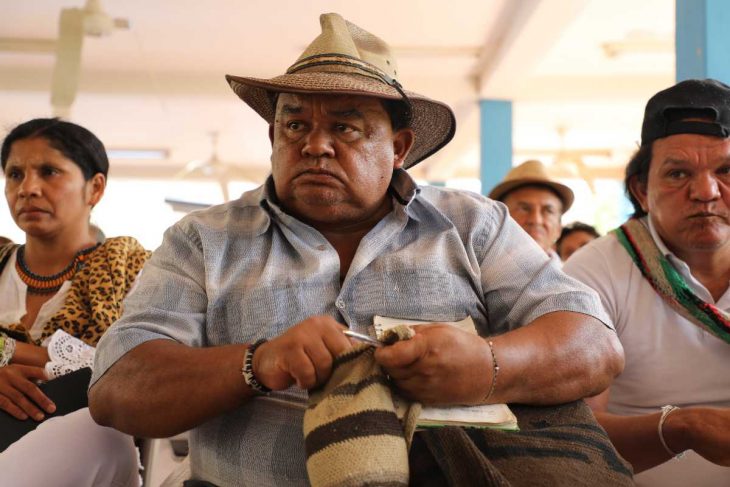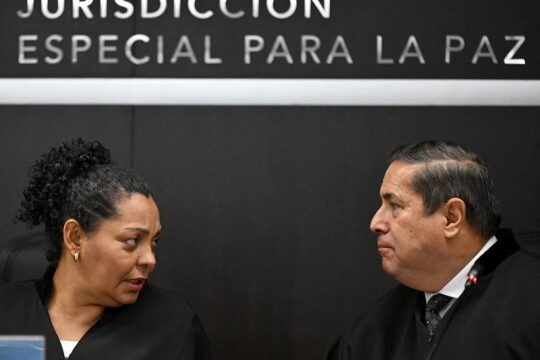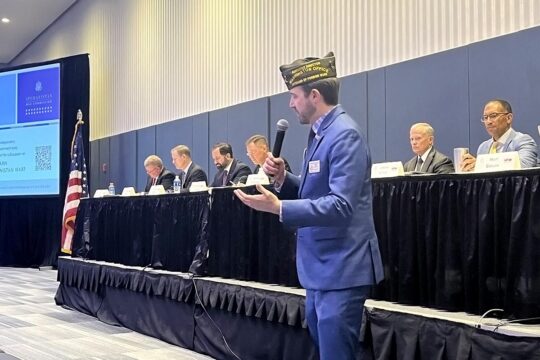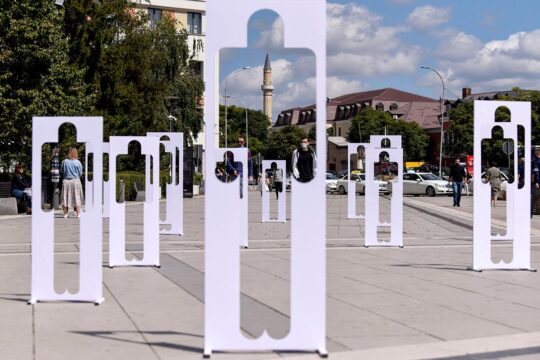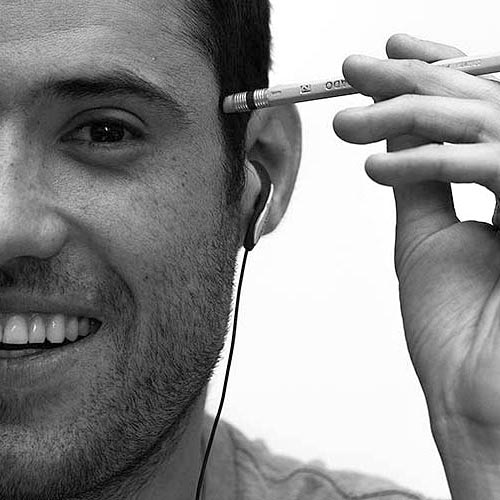Two weeks ago, a hundred Kankuamo Indians gathered in a school within their reservation in Atanquez, on the cloudy slopes of the Sierra Nevada de Santa Marta mountain range in northern Colombia. Over nine hours they reviewed the videos in which eight officers and nine soldiers of the Colombian military described the extra-judicial executions of eight members of their community. After seeing footage of their testimonies, they began identifying parts where their recollection about the events that occurred over a decade ago differed and came up with new questions for them.
Accompanying them were a justice from the Special Jurisdiction for Peace (JEP) and two psychologists, with whom they had met several times over the past year and who had brought the testimonies personally.
This community assembly – and dozens of similar hearings – reveal the ambition of Colombia’s transitional justice system in its quest to punish the most serious crimes committed during a 52-year-long armed conflict. They also give an insight into the challenges ahead and the wider questions of victim participation that still require answers.
A place for all victims?
Placing victims in the centre has been, at least on paper, one of the main aspirations of the peace deal signed by the Colombian government and the former Revolutionary Armed Forces of Colombia (FARC) in 2016, as well as the transitional justice system that stemmed from it.
Guaranteeing their participation throughout proceedings is one of biggest challenges for the JEP, as it is locally known – that began operating exactly two years ago as the transitional justice’s judicial arm. That will be no easy feat in a country where 8,9 million persons – out of a population of 48 million – are officially registered as victims and where thousands genuinely expect their cases to be investigated, prosecuted and punished.
The peace deal states that victims should be able to participate throughout the proceedings, in order to guarantee the satisfaction of their rights to truth, justice, reparations and non recurrence. In fact, more lenient sanctions are conditional to former FARC combatants, as well as members of the military and other persons who committed international crimes, acknowledging their responsibility, telling the truth, and personally helping redress victims.
Seven macro-cases
Laying the groundwork for this victim-centred approach is one thing. Implementing it is another though. Currently the JEP is working on seven macro-cases detailing different representative crimes committed during Colombia’s conflict and identifying those responsible for them. Two of these focus on FARC’s involvement in kidnapping and forced recruitment of child soldiers; another case details extrajudicial executions carried out by the military, while several regional cases document human rights violations carried out by various actors in specific parts of the country.
To allow the participation of victims, JEP justices divided the investigation phase in four distinct moments, each of which includes a specific mechanism for victims to participate. However, they quickly realised, the uniqueness of each case demanded some flexibility.
“Our challenge is to find a middle ground in which we can ensure a robust participation from victims, but also that justices can manage and lead this process of macro-cases,” says Óscar Parra, one of the justices on the Judicial Panel for Acknowledgment responsible for the first stage of the JEP’s work.
“What we have discovered is that cases are so different that each justice proposes the ideal methods for participation and the judicial panel in full verifies that these comply with the best national and international standards,” says fellow justice Julieta Lemaitre, who leads investigations on FARC’s kidnappings.
This creativity seems necessary given the scale of atrocities, although flexible participation schemes designed on a case-by-case basis could garner the JEP criticisms in the future from both perpetrators and victims who could claim that rules are not clear from the outset or establish differences between them.
Hearing and counting victims
The JEP’s initial endeavour has been to get victims, the organizations that group them and those who defend them legally to submit reports detailing their ordeals.
So far the special tribunal has received 249 reports. At least 125 of them have been submitted by victims and legal organizations representing them, with a hundred more coming from the government-run National Centre for Historical Memory that has spent the past decade documenting the effects of the armed conflict.
Initially JEP justices thought two years would be enough for victims to present their reports, but this idea was proven wrong. Demand has been such that the tribunal recently extended this deadline by one full year, until March 2021. This extension can also give the tribunal a chance to continue building bridges with victims who are sceptical of its work, including the group of women who denounce having suffered sexual violence while they were FARC members.
By way of these reports, victims have helped the JEP decide which international crimes it prioritised as it began working. As they opened the first macro-cases, justices also began establishing the universe of victims for each of those crimes. They soon realised no one method to identify them would suffice. For example, victims of kidnapping and sexual violence have traditionally been less prone to public visibility and to group together, as opposed to the well-organised victims of extrajudicial executions.
This meant that a special effort was needed to find and persuade victims who keep a low profile to register as an interested party in the fledgling proceedings. Justices working on the kidnapping case designed a national campaign to this end. They asked the Government’s Victims’ Unit to send text messages to the 37,000 victims of this crime included in its national registry, instructing them how to register themselves if the former guerrilla had been responsible for their ordeal. They cross-checked databases at the Attorney Generals’ Office, identifying victims who had not been reached yet and drafted a script which legal aids followed to call them. They also trained local ombudspersons and aired ads on community-run radio stations serving rural areas.
These efforts paid off. They were expecting 1,600 FARC kidnapping victims, according to a simulation by an industrial engineer working with them. So far 1,709 victims have sought accreditation. “If you’re a victim of kidnapping, you should know by now that you have the right to become a party in the case,” says Julietta Lemaitre, who was a professor in socio-legal studies before joining the JEP. A similar method will likely apply to find former child soldiers, who also tend to keep a low profile.
This task has proven daunting on account of the sheer magnitude of victimization. Two weeks ago, justices working on one of the regional cases documenting human rights violations carried out by various actors in Cauca and Valle del Cauca accredited 100,000 victims living in 31 different indigenous reservations.
Confronting perpetrators’ accounts
Since last year, JEP justices have been questioning hundreds of persons in order to build each macro-case. In lengthy confidential hearings, alleged perpetrators – including the 25 former members of FARC’s Central High Command - have begun answering questions from the topic lists drawn up by the special tribunal.
So far 350 former FARC rebels have provided collective written testimonies on that guerrilla's practice of kidnapping, with 187 of them also presenting exhaustive individual accounts orally. In a similar vein, 207 former members of the Armed Forces and Police have individually given testimony on extrajudicial executions (known in Colombia as ‘false positives’), with 43 of them also submitting written statements.
Since December, justices began giving kidnapping victims access to these testimonies, sharing both the collective accounts of FARC’s top brass as well as those given by the leaders of the guerrilla bloc directly responsible for their ordeal. Their reasoning for this is that there was a national directive on extortive kidnapping - ‘economic retentions’ in their language- but there was also a certain autonomy among blocs that led to differing practices.
Registered victims received emails asking them if they would like access to these accounts, whether in the original video footage or in transcription, in case they would rather not see their faces. In total, for each FARC bloc there are some 20 hours of footage and 500 pages in print. So far 700 victims have welcomed the idea.
JEP officials designed three ways for victims to access this information. Around 300 persons attended full-day group sessions in five cities, where they examined the material with justices and psychologists. Other victims began receiving last week a log-in to a secure online site where they can also view the material. Finally, victims can also visit the JEP’s headquarters in Bogota and see the complete case file.
This methodology largely veers away face-to-face encounters between victims and perpetrators, in a bid to avoid revictimise those who have suffered. Although this type of encounters could take place further on, the special tribunal has insisted it wants to build truth through a restorative dialogue between victims and perpetrators. Some victims and human rights lawyers disagree with this view, insisting that it is a paternalistic concern and demanding to be able to question defendants in person.
However many victims value the possibility of commenting defendants’ testimonies. “They have so far admitted several important things, but they do so in their own way. I know how much my father suffered during his kidnapping and they’re failing to address how they treated people. They were more severe and violent than what they claim,” says Angélica Mora, who participated in one of the sessions and asked former FARC commanders to acknowledge the degrading treatment they inflicted on their hostages. “This is something they should consider, for us victims to see they’re really contrite.”
First accusations, probably mid-2020
Still some victims remain wary of the tribunal’s work. Ximena Ochoa, a cattle rancher whose mother was kidnapped for ransom by FARC in 1991, registered as a party in the case and received the e-mail on access to defendants’ testimonies. But she decided not to go, arguing that she doesn’t have a lawyer and doesn’t trust the human rights organisations the JEP offered her as legal aids. “Without a lawyer I can’t do anything. It curtails effective participation,” she says. Her case underscores how important it is for the transitional justice to increase outreach efforts with victims who like her ended up opposing the peace deal.
The ensuing observations – like the 195 pages submitted by the Kankuamo Indians - will be transferred to the defendants’ lawyers, so they can respond and provide more information. All of this evidence will be taken into account by JEP justices as they draft their indictments, which will individually identify those persons deemed most responsible of ordering and committing the crime. Its first accusations will probably come out in mid 2020.
This will then lead to public hearings in which the accused can decide to own up to their role and therefore qualify for a special sanction of 5 to 8 years in a non-prison setting. In case the accused acknowledge their responsibility, the corresponding case files will likely come out to the public domain, although when and how this will happen is not clear yet.
In case defendants do not accept the charges, case ledgers will likely remain confidential as they are referred to the JEP’s prosecution unit. Their responsibility would then be proven in the adversarial track of the transitional justice system, a procedure that mirrors the ordinary criminal justice system more closely.
Balancing participation and indictments
The gigantic number of victims and perpetrators leaves several questions going forward. One is how the JEP will manage victims’ expectations, given that it will be impossible for all of them to participate in the same way. Although the JEP’s timeframe is 10 years to present indictments and 15 years to conclude its activities, its decisions on what to prosecute and what not will probably pain many victims.
This means that the tribunal will need to strike a balance between allowing participation and building its indictments. “In a transitional justice scenario, we have to ask ourselves how feasible it is to spend four or five years investigating one crime when we have 200 reports from victims. My personal view is that the JEP must foster as many restorative settings in which victims’ voices are heard as possible, finding ways to reconcile their personal expectations with the challenges of pursuing macro-cases,” says Parra, a criminologist who previously worked at both the Inter-American Court of Human Rights and Commission.
That could include, he argues, devising complementary solutions such as hearings in which defendants who are not deemed most responsible and thus avoid prosecution can address questions from victims. In this line, they seek to continue ensuring that every stage of the proceedings incorporates a restorative ingredient and psycho-social support.
Another constant challenge is Colombian society’s expectation of seeing former FARC commanders admitting their deeds publicly. However, this clashes with the sensitive nature of much of the information and the importance of keeping a safe space for victims.
Many victims are more open to a public approach: the Mothers of Soacha, a group of women whose sons were killed in extrajudicial executions, asked for the October hearing in which they reviewed perpetrators’ accounts to be open to the media and streamed live. Likewise, several prominent politicians who were kidnapped by FARC chose to present their reports publicly, while most of the other victims preferred eschewing the spotlight. The Kankuamo Indians, on the other hand, asked for their hearing to be confidential given the recent uptick in violent incidents in their mountainous region.
How the JEP ultimately answers these questions will determine if its complex and ambitious route for victim participation can help rebuild trust among citizens and towards state institutions.


